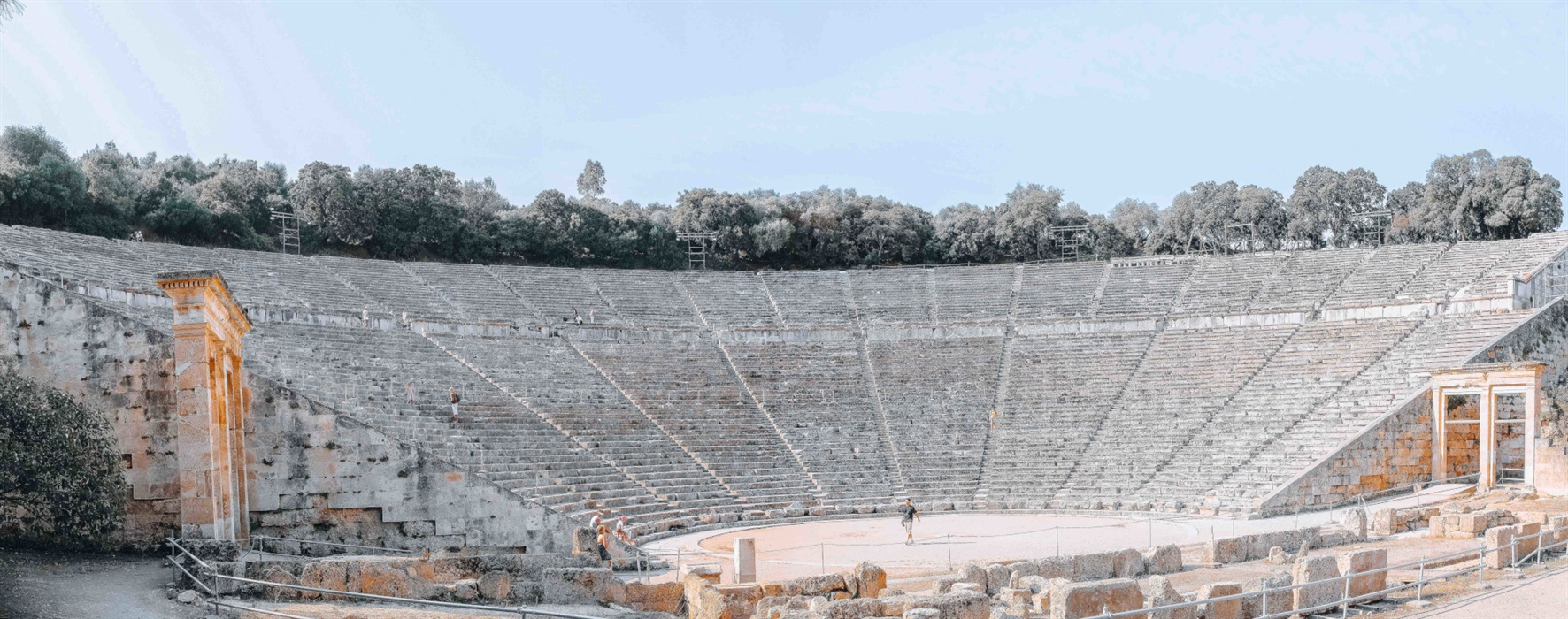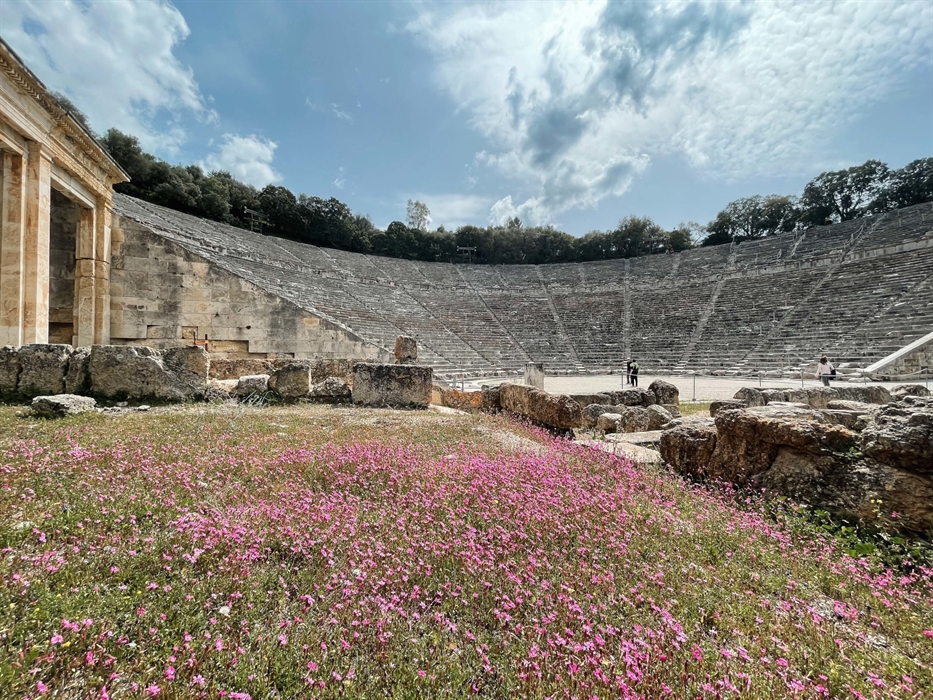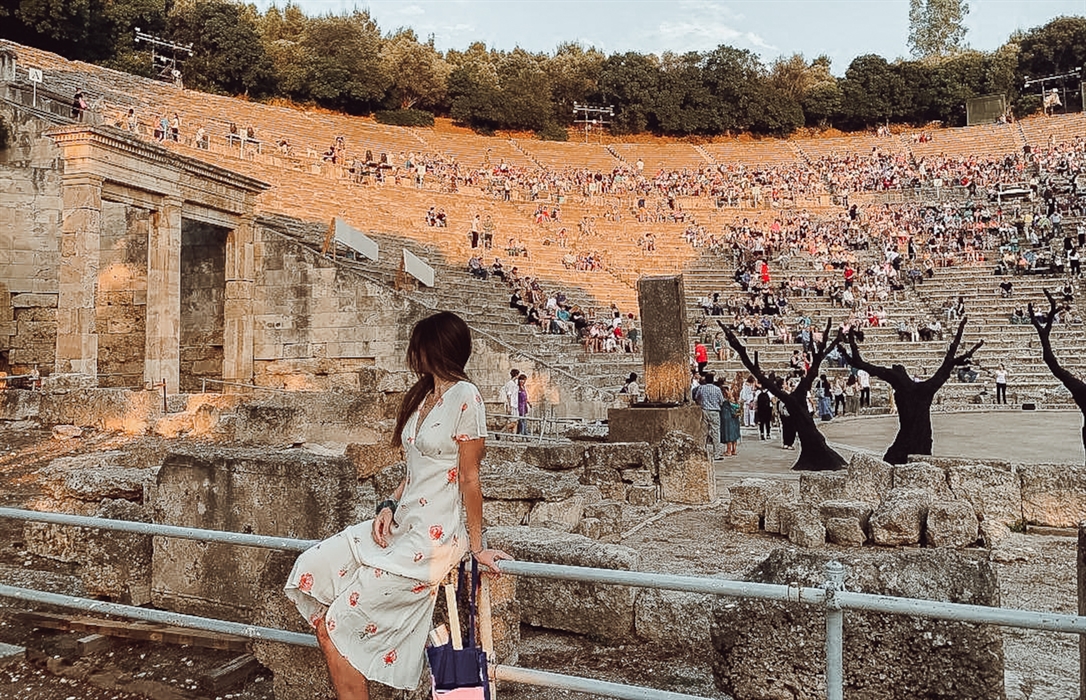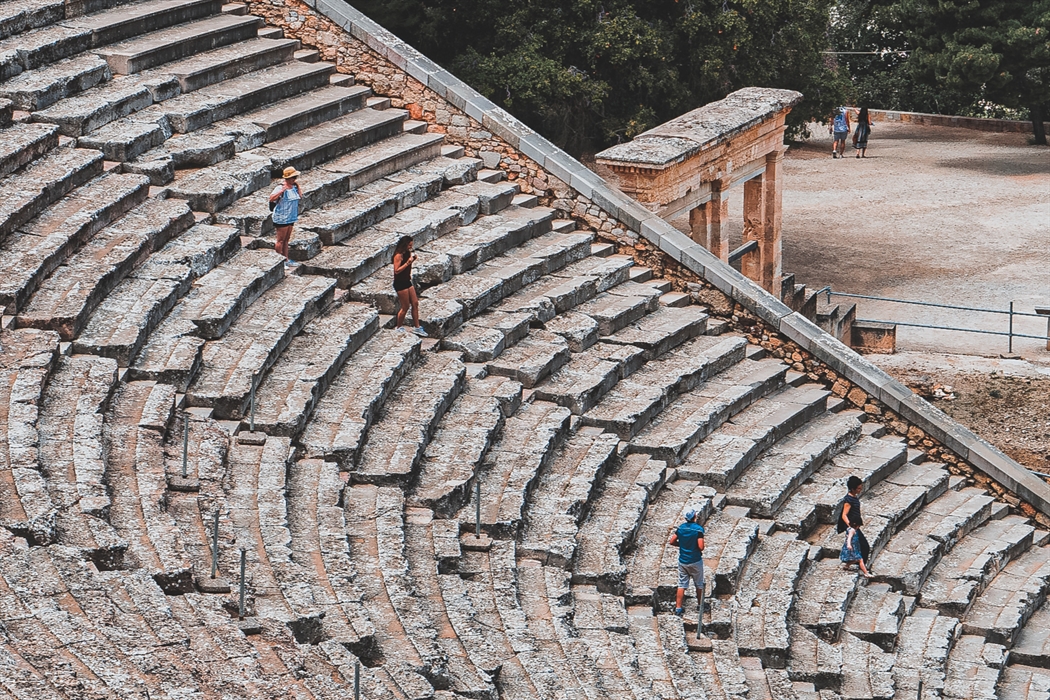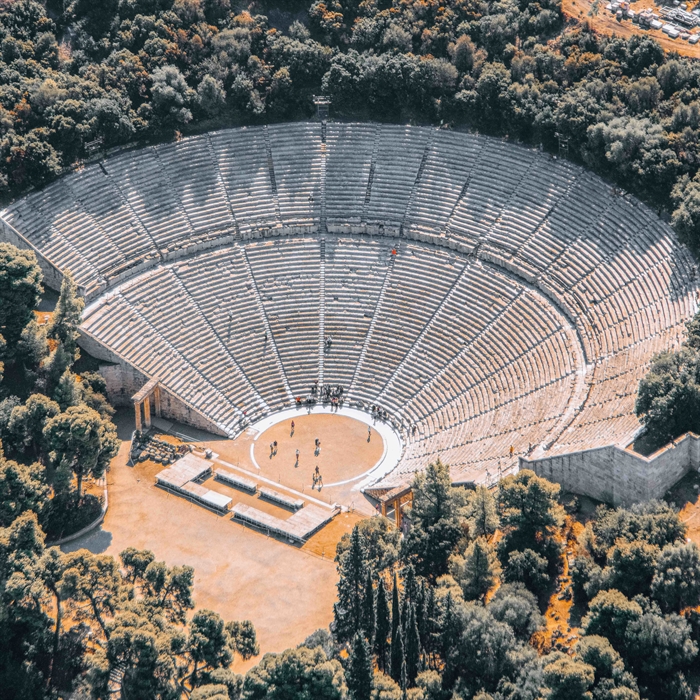The ancient theatre of Epidaurus
As a timeless magnet of culture, the crowds have flooded the ancient theatre to see the Epidaurus Festival every summer for many decades. It is renowned for its acoustics and unparalleled architectural proportions.
Since 1988, the ancient theatre of Epidaurus, together with the Asklepieion, has been included in the list of UNESCO World Heritage Sites. Continuing the ancient tradition, from 1955 to the present day, its stage has hosted unforgettable performances. And viewers from all over the world have been introduced to the original concept of entertainment (“ψυχαγωγία” in Greek).
"Education of the soul": This is the true protagonist of the theatre built at the Southeast end of the Asklepieion of Epidaurus, one of the most important theatres of ancient times. The prevailing view of experts is that the theatre was built in two phases: In the 4th century BC, during which there was significant building development at the sanctuary of Asclepius, and during a second phase in the middle of the 2nd century BC.
The theatre with its unparalleled architectural proportions and absolute harmony with the surrounding landscape is the best-preserved monument in the archaeological site. It has excellent acoustics due to the perfect geometry of its design - it even impressed the traveler Pausanias when he visited the theatre in the mid-2nd century.
In antiquity, the drama games, along with the athletic games, were part of the worship events in honor of Asclepius. The theatre, which had a capacity of 12,000 spectators, retained the characteristic structure of Hellenistic theatres and no interventions were made during the second half of the 2nd century when the Romans added new buildings to the Asklepieion, nor in the middle of the 4th century when the site was reorganised.
The theatre seating, which has a slightly ellipsoidal shape, follows the contours of the slope of Mount Kynortion and consists of two parts separated by a perimeter corridor. The perfectly circular orchestra pit has a diameter of 19.5 m. The stage structure was elongated and tangential to the orchestra. It had two parts: the elevated proscenium with an Ionic façade, and the two-storey stage building, on the side of which there were large openings so the painted scenery panels could be put in place.
Worship at the Asklepieion and the operation of the theatre continued even after the official prohibition of the ancient religion by Theodosius the Great in 426 AD.
The site was finally abandoned after the devastating earthquakes of 522 and 551 AD. During the Venetian and Ottoman occupation there was considerable amount of looting.
In 1881, the Archaeological Society of Athens began excavations. The stage structure had been destroyed, but the seating was found in good condition. Many years of work followed.
In the early 20th century, the revival of ancient drama began in Greece (Delphic festivals organised by Eva Palmer and Angelos Sikelianos ) and the National Theatre was founded. Immediate priority was given to the cultural and economic use of the ancient theatres, including Epidaurus.
The theatre took its present form with successive restoration interventions by the excavator P. Kavvadias, A. Orlandos (1954-63) and, since 1988, the Committee for the Conservation of Epidaurus Monuments of the Ministry of Culture.
Read about the performances at the ancient theatre of Epidaurus and the Archaeological Museum of Epidaurus
Did you know that
As is often said, the acoustics of the theatre of Epidaurus are so impeccable that the spectators sitting in the upper tiers can even hear the whispering of the actors on stage and in the orchestra.
See also information about the Archaeological Museum of Epidaurus.
*Source of the texts: Athens Epidaurus Festival.
The history of the performances at Epidaurus
From 1935 till our days many celebrated actors, directors, scenographers and musicians have delighted audiences at the Epidaurus theatre. The summer programme of the Epidaurus Festival continues to attract thousands of people from all over the world.
There have been countless wonderful productions at Epidaurus, but two of the early performances remain ingrained in the cultural history of the theatre: Bellini's Norma (1960) by the National Opera, and Cherubini’s Medea (1961) directed by Alexis Minotis and with sets and costumes by Yiannis Tsarouhis. The star of both performances was the famous Greek soprano Maria Callas.
A few years before, in 1935, the first official performance of the Symphony Orchestra of the Athens Conservatory conducted by Dimitris Mitropoulos was recorded in the theatre of Epidaurus. In 1938 Dimitris Rontiris staged the first performance of Sophocles' Electra since antiquity. The star was Katina Paxinou, and the show was performed without sets, costumes, or lights. The media of the time described it as a "holy pilgrimage".
The "Epidaurus Festival" was established in the summer of 1955, at the same time as the Athens Festival. The two institutions were then merged.In 1957 the theatre staged one of Aristophanes’ comedies for the first time.Until 1975, the only shows staged at Epidaurus where productions by the Greek National Theatre. From then on, the theatre has been hosting performances by other theatre companies from Greece and abroad who have staged Shakespearean plays, ancient tragedies, opera, ballet and many more.
Among the actors, directors, scenographers and musicians who have delighted audiences in Epidaurus are: The couple Alexis Minotis and Katina Paxinou, Eleni Papadaki, Anna Synodinou, Manos Katrakis, Irini Pappa, Alexis Solomos, Karolos Koun, Nikos Kourkoulos, Spyros Evangelatos, Yiannis Tsarouchis, Melina Mercouri, Andreas Voutsinas, Michalis Kakogiannis, Alekos Alexandrakis, Tzeni Karezi and Kostas Kazakos, Aliki Vougiouklaki, Manos Hatzidakis, Dimitris Mitropoulos, Karyophillia Karabeti, Yannis Houvardas and others. From 1982 onwards, many performances at Epidaurus were directed by Sir Peter Hall. Foreign artists who have appeared in Epidaurus include Gérard Depertier, Isabella Rossellini, José Carreras, Montserrat Cambagé, Maurice Bézard and more. And of course, over the years many VIPs and celebrities from all over the world have attended performances at Epidaurus.
Location
Find the destination on the interactive map below.
Categories
Σχετικό περιεχόμενο χρηστών (UGC)
Ενημερωθείτε για ενδιαφέροντα θέματα γύρω από τον προορισμό μέσα από το περιεχόμενο των χρηστών μας
Discover 7 hidden gems of the Peloponnese
Many of you may have already visited some of the most renowned attractions…
TOP 10 archaeological museums in the Peloponnese
Olympia, Mycenae, Epidaurus, Diros Cave, Ancient Corinth, Messene and…
TOP 10 Castles in the Peloponnese
Castles galore! Mystras, Monemvasia, Palamidi, Methoni, Koroni,…
Newsletters
- About us
- FAQ's
- Map
- Tourism information centers
- Disclaimer
- Sitemap
- Our brand
- Media roum
- Adding your bussiness
- Corporate
- MICE

Peloponnese. Greece beyond the obvious





Design and creation from Cosmote
Marinas and Moorings
Diving centers
Get inspired
- Media gallery
- Blog
- The Peloponnese in the media
- Your feedback
- Users' general content
- Users' local products
- Users' events content
- Ask a local
More
- Accommodation
- Travel agencies
- Restaurants
- Services
- Destinations Map
- Weather
- Public transport
- Events
- Frequently asked questions
- Useful phones
- B2B
- Destination Data
- Contact

